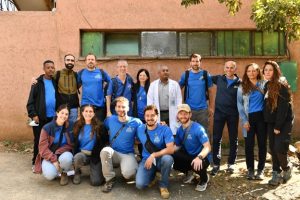
Forest cultivation is not simply planting seedlings. It comprises various things. Managing forests at global level has been changing from time to time and vary from country to country, said Dr. Yigremachew Seyum, Advisor to the International Green Development Institution.
As to him, starting from the initial phase of the industrial revolution, studies were carried out on the forest management and utilization.
Centuries ago, forest resources were utilized arbitrarily as if it is infinite and in some countries such attitude has prevailed to date.
Later on, when the demand to forest products increased, the resources started to dwindle leading to the introduction of small scale forest cultivation to avert the situation.
After the industrial revolution in Europe, due to economic progress life style was changed. Consequently, the increase in people’s interest for wood products caused increase in the price of the products. According to Yigremachew, the flourishing of market necessitated the development of forest economy and timber production expanded. Side by side with this, to replace the demolished forests, rapid reforestation work began and new way of thinking for sustainable usage of the resource developed.
Utilizing the forest resource only for facilitating industrial revolution became an outdated fashion.
Forest development became purposeful which targets two things. One is ensuring sustainability and the other is protecting the ecosystem which underlines the environmental factors.
When liberal thinking accentuated, sustainable usage of forest became highly recognized and the forest concept intermingled with economy, social security and the environment.
The concept was developed by both natural and social sciences. Selecting of various plants species and preservation began and cultivating and marketing the products became demand driven. Understanding also grew up satisfying forest products demand impossible without managing it properly.
The vitality of multifaceted efforts for protection of the resources based on scientific research also started to gain ground.
It is proved that, economic development and forest coverage in many countries is intertwined. For example, in countries with large forest coverage on their land such as Russia, Canada and Brazil the situation is clearly visible in their agricultural sector. Their large scale irrigation and surplus production boosted by their water resource.
The recent study conducted by the U.S. based non-governmental organization indicated that, in Ethiopia forest contributes 12 percent of the nation’s GDP. Contrary to this, study by the Central Statistics Authority indicates that, the contribution of forest to the economy is only 4 percent. Hence, reconciling the two studies outcome is essential.
Unless critically seen, planning for afforestation and exploiting the resource will be a challenge.
To make the forest issues as a priority agenda, strengthening the sector in terms of budget, institution and human resource is vital. But in our context there is huge gap which needs to be closed.
Identifying and knowing the role of forest in economic growth is essential and when this happens prioritizing the sector can be easy.
In Ethiopia, bio mass is a major household energy resource particularly in the rural parts of the country. It is derived from forest and vegetation cover.
According to the official report, annually 156 million cubic meters of wood is cleared for various purposes and out of it, 90 percent is utilized for house hold energy. This indicates that the resource is at risk.
Seen from a different angle the clearance of forest calls for the vitality of searching for alternative energy sources particularly renewable ones. On the other hand, it shows the growing demand for forest products particularly in urban centers.
Developing forestry through utilizing the resource in a sustainable manner could create job opportunities to the youth.
Removing bureaucratic hurdles to the private sector to involve in forest cultivation contributes a great deal to the nation’s economic growth.
Ethiopia has a forest of Sudan Grass, locally known as Kerkha on more than one million hectares of land which puts the nation as the first in Africa. Similarly it has an abundant gum plantation which enables to generate income.
The Sudan grass which can be harvested in barren lands is useful to make various wooden products.
Recently, strategic plan helpful to exploit the resource which is to be implemented for the next ten years is prepared and soon will begin.
It is proved that up to 10,000 can grow up in a hectare of land. But harvesting the plant takes 5 to 6 years.
Companies endeavor in such venture may face financial scarcity during these years. Hence, banks should prepare a scheme to provide some form of credit facilities. In such a way both supplying products to the market and creating job opportunities will be possible.
According to Yigremachew, farming and water harvesting is unthinkable without cultivating and protecting forest.
The geographical landscape of the country cannot be separated from forest cultivation. As it is mountainous, the absence of vegetation cover makes the soil to be taken away by running water in the rainy season.
The official estimation suggests that, by the year 2050, the number of the population of the nation will rise to 188 million. Hence, protecting forest can boost water harvesting which is key for large scale irrigation farm development helpful for realizing food self-sufficiency.
Currently, in the low lands of the country irrigation farming is flourishing but to sustain the practice, containing sufficient water resources through conservation work on the mountains is vital.
In line with this, forest cultivation also plays crucial role for the nation’s adaptation and mitigation programs which are part of the nation’s development of Climate Resilient Green Economy.
Conservation prevents land degradation and soil erosion while replenishing underground water.
Though the level of the nation’s carbon emission to the atmosphere is insignificant, the nation’s forest has global value in sequestrating carbon which mitigates climate change.
Though massive seedling plantation has been practiced in Ethiopia since 2008, so far it is not known how many of it has sprouted.
Nevertheless, it is a good news that out of the 3 billion seedlings planted in the last rainy season 84 percent of it has been fruitful.
The Ethiopian Herald June 28, 2020
BY ABEBE WOLDE GIORGIS





